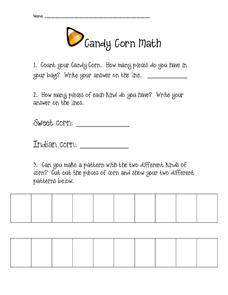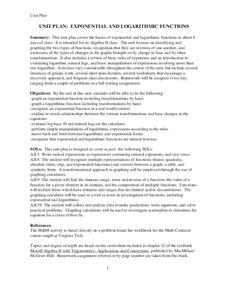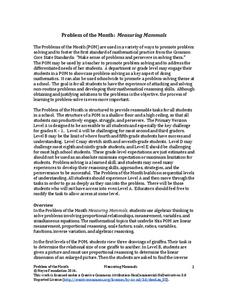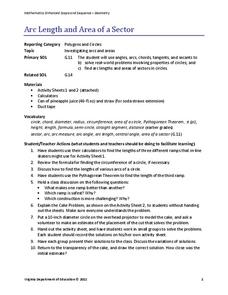Computer Science Unplugged
Twenty Guesses—Information Theory
How do we determine how much information to include and what can be left out? By playing a game of 20 questions, the class generates the best strategies for finding a number. They then move on to guessing the next letter in a short...
Math in English
Number Patterns
Build the pattern recognition skills of young mathematicians with this simple skills practice worksheet. Given nine different sequences of two-digit numbers, children must identify the pattern and determine the next three numbers in...
Curated OER
Number Sequencing Packet
This dynamic 4-page packets challenges students to practice number sequencing. The sequences get progressively more difficult. Your class must count by ones, backwards, by twos, and by threes. Students can complete this packet as an...
NASA
Solar Systems: Sequences and Probabilities
For this sequences and probability activity, students solve 3 problems by writing out all the possibilities for the solution and they use probability to find their answers. They determine the probability of solar flares happening on a...
Curated OER
Sequences
In this sequences instructional activity, learners find the limit of a sequence. They explore Ulam's sequence. Students calculate differences for terms in a quadratic sequence. this four-page instructional activity...
Curated OER
Candy Corn Math
In this autumn themed math activity, students complete counting, classifying, and sequencing activities with candy corn. They receive bags of candy corn and sort the pieces. They cut out small pictures of the candy to glue onto tables on...
Virginia Tech
Unit Plan: Exponential and Logarithmic Functions
A six-day unit for algebra II on exponential and logarithmic functions builds upon Chapter 12 of Merrill Algebra II with Trigonometry; Applications and Connections. The text provides assistance in the depth of instruction...
Noyce Foundation
Measuring Mammals
Explore the meaning of scale and proportion with a set of five activities that examines the topic from elementary through high school. The first lessons explore ratio by examining pictures of different sizes. The next three activities...
Math Wire
SnowDaySnowDaySnowDaySnowDay...
How many times can you cheer about a snow day before you get to the 100th letter? Find out with a creative word problem that challenges young mathematicians to determine what the 100th letter will be in a sequence of letters.
Illustrative Mathematics
Measuring Blocks
Stack them together to get a measurement. The short activity has pupils work in pairs to measure the lengths of two blocks and then determine the length of the two blocks together. The groups then determine an equation that represents...
Curated OER
Missing Number Game
Math partners help each other with number sequences in this interactive game. Young scholars arrange number cards in order, and Partner A closes his eyes. Partner B removes one card, after which Partner A must determine which card has...
Curated OER
Solving a Simple Maze
It is a-maze-ing how lost one can get. Teams reconstruct a simple maze and solve it. Participants create an algorithm that a robot would follow in order to solve the maze as well. The activity includes an extension directing pupils to...
Virginia Department of Education
Arc Length and Area of a Sector
What do skateboarding and baked goods have in common with math? You can use them to connect half-pipe ramps and cakes to arcs and sectors. Pupils compare the lengths of three different ramp options of a skate park. They calculate the...
Oklahoma State University
Hairy Heredity
Young scholars learn that heredity comes down to the flip of a coin with this cross-curricular math and science lesson plan. Using smiley faces as a model, students toss coins to determine which dominant or recessive...
EngageNY
Analyzing a Data Set
Through discussions and journaling, classmates determine methods to associate types of functions with data presented in a table. Small groups then work with examples and exercises to refine their methods and find functions that work...
Curated OER
Number Patterns and Sequences
In these patterns and sequences worksheets, students complete 4 pages of activities to learn number patterns and sequences. Students complete 11 problems.
Teach Engineering
Discovering Phi: The Golden Ratio
Fe, phi, fo, fum. This activity leads pairs to find the ratio of consecutive terms of the Fibonacci sequence. The pairs find that the Fibonacci sequence can be found in many places. A discussion with the class shows that the ratios...
EngageNY
Analyzing Residuals (Part 1)
Just how far off is the least squares line? Using a graphing calculator, individuals or pairs create residual plots in order to determine how well a best fit line models data. Three examples walk through the calculator procedure of...
Curated OER
Valentine Pattern Completion
In this sequencing activity, students cut out pictures of 4 decorated hearts. They glue the hearts to finish the patterns at the top of the page in this Valentine themed worksheet.
Math Salamanders Ltd.
Counting on by Digits Sheet 2
In this number sequence activity, learners fill in 40 missing numbers in sequence on 10 different number lines. Students calculate each single-digit step up for each one.
Curated OER
Counting in Halves in Sequences
In this counting halves worksheet, students count halves in sequences, filling in the missing numbers. Sequences go up or down in steps of a half. A reference web site is given for additional activities.
DK Publishing
Connect-the-dots Dinosaurs: Reading Numbers
Connecting dots activities can be great number sequencing practice. Here are two dinosaur dot-to-dot pictures that are intended to help learners count, sequence numbers up to 40, and recognize number words. Who doesn't love a good...
Curated OER
Hopping by 2s, part 2
Explore skip counting by twos with young mathematicians as they complete these engaging activities. First, they color in squares to represent counting by twos in an even sequence and an odd sequence. Next, they connect dots (by twos) to...
Curated OER
Multiples of 6 #2
Count by six with these helpful activities. After completing number sequences and multiplication problems from the six times table, third graders solve problems that are written out at the bottom of the page. An excellent way to work on...

























